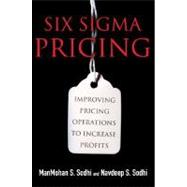
Note: Supplemental materials are not guaranteed with Rental or Used book purchases.
Purchase Benefits
What is included with this book?
| Preface | p. xix |
| Motivation and Context | p. 1 |
| Why Pricing Operations and Six Sigma Pricing | p. 3 |
| Introduction | p. 4 |
| Who Should Read This Book and How They Should Read It | p. 6 |
| Why Target Pricing Operations | p. 8 |
| Pricing Challenges and Six Sigma Pricing | p. 10 |
| What Six Sigma Pricing Is | p. 15 |
| What Six Sigma Pricing Is Not | p. 16 |
| Summary | p. 17 |
| Profit Leaks from Inefficient Pricing Operations | p. 19 |
| Introduction | p. 20 |
| Examples of Price Leaks | p. 21 |
| Why Price Leaks Occur | p. 29 |
| The Role of the Pricing Function | p. 35 |
| Summary | p. 37 |
| Case Study-Pricing Operations and Six Sigma Pricing | p. 39 |
| Introduction | p. 40 |
| Background | p. 41 |
| Six Sigma | p. 42 |
| Define | p. 43 |
| Measure | p. 44 |
| Analysis | p. 48 |
| Improvement | p. 50 |
| Control | p. 51 |
| Results | p. 52 |
| Summary | p. 53 |
| Basics-Pricing Operations and Six Sigma | p. 55 |
| Price and Pricing | p. 57 |
| Introduction | p. 58 |
| Different Types of Prices | p. 59 |
| Different Levels of Pricing | p. 63 |
| Summary | p. 68 |
| Pricing Operations | p. 71 |
| Introduction | p. 72 |
| Processes and Roles | p. 72 |
| List Price Increase | p. 74 |
| New Product Launch Pricing and Lifecycle Maintenance | p. 75 |
| List Price Increase Due to Increase in Input Costs | p. 79 |
| Promotions | p. 85 |
| Discount-setting and Concession Process | p. 87 |
| Analysis, Report, and Review Processes | p. 88 |
| Summary | p. 89 |
| Six Sigma | p. 91 |
| Introduction | p. 92 |
| Historical Background | p. 92 |
| Why Six Sigma and Not Five or Seven | p. 95 |
| Misperceptions of Six Sigma | p. 98 |
| Application of Six Sigma to Non-manufacturing Situations | p. 99 |
| Five Steps of a Six Sigma Project (DMAIC) | p. 100 |
| Summary | p. 102 |
| Tools for Six Sigma | p. 105 |
| Introduction | p. 106 |
| Tools for the Define Phase | p. 106 |
| Tools for the Measure Phase | p. 113 |
| Tools for the Analyze Phase | p. 116 |
| Tools for the Improve Phase | p. 126 |
| Tools for the Control Phase | p. 128 |
| Summary | p. 129 |
| Doing a Six Sigma Pricing Project | p. 131 |
| Selecting a Six Sigma Pricing Project | p. 133 |
| Introduction | p. 134 |
| Acme | p. 141 |
| Summary | p. 147 |
| Define Phase | p. 149 |
| Introduction | p. 150 |
| The Charter | p. 150 |
| Customers and Their Requirements | p. 155 |
| High-level Process Map | p. 155 |
| Define Checklist | p. 156 |
| Acme | p. 156 |
| Summary | p. 165 |
| Measure Phase | p. 167 |
| Introduction | p. 168 |
| Process Map | p. 169 |
| Data Collection Plan | p. 170 |
| Acme | p. 176 |
| Summary | p. 181 |
| Analyze Phase | p. 183 |
| Introduction | p. 184 |
| Process Analysis | p. 185 |
| Root-Cause Analysis | p. 187 |
| Data Analysis | p. 188 |
| Acme | p. 189 |
| Summary | p. 198 |
| Improve and Control Phases | p. 201 |
| Introduction | p. 202 |
| Improve | p. 202 |
| Control | p. 203 |
| Final Presentation | p. 204 |
| Acme | p. 205 |
| Summary | p. 218 |
| Enterprisewide Deployment | p. 219 |
| Deploying Six Sigma Pricing Enterprisewide | p. 221 |
| Introduction | p. 222 |
| Developing an Enterprisewide Plan for Six Sigma Pricing | p. 224 |
| Goals for Enterprisewide Deployment | p. 229 |
| A Starting Toolset for Six Sigma | p. 231 |
| Pitfalls and Challenges | p. 232 |
| Summary | p. 237 |
| The Takeaway | p. 239 |
| Notes | p. 245 |
| Index | p. 249 |
| Table of Contents provided by Ingram. All Rights Reserved. |
The New copy of this book will include any supplemental materials advertised. Please check the title of the book to determine if it should include any access cards, study guides, lab manuals, CDs, etc.
The Used, Rental and eBook copies of this book are not guaranteed to include any supplemental materials. Typically, only the book itself is included. This is true even if the title states it includes any access cards, study guides, lab manuals, CDs, etc.